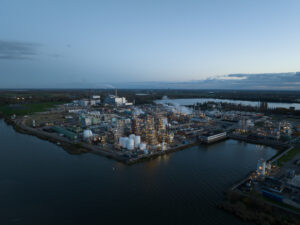A Quarter of Rural Water Systems Likely Contain Forever Chemicals
USGS research confirms widespread PFAS contamination in drinking water—including in rural communities and private wells that are almost never tested. Photo: Luna Anna Archey / High Country News.
Photo: Luna Anna Archey / High Country News.
This article was originally published July 19, 2023 at High Country News.
Since 2016, the United States Geological Survey has sampled water in taps nationwide, looking for the toxic “forever chemicals” known as PFAS — common chemicals that accumulate in the body with devastating health effects over time. The agency’s findings, released last week, confirm just how widespread contamination has become, including in rural communities where little data has existed before.
About a quarter of rural tap water is likely contaminated, their study suggests. Those communities frequently use small public utilities and private wells — systems that serve about a third of all U.S. residents but have long been ignored by most state and federal PFAS testing. Small public systems were not subject to testing by the Environmental Protection Agency until this year, when the EPA stepped up testing nationwide and began to weigh the first-ever federal regulation of these chemicals. Private wells are still left out; the EPA doesn’t monitor or regulate them.
Without testing or research, these communities “don’t have really good information about the quality of their drinking water,” said Kelly Smalling, a USGS hydrologist and author of the study. This means that they’re often unaware of their risk, making them more vulnerable to the health effects of PFAS. She hopes that this study is one step in changing that.
PFAS — per- and polyfluoroalkyl substances — are extremely common. There are more than 9,000 types, and over the last 40 years, they’ve become ubiquitous in goods from nonstick pans to raincoats to microwave popcorn bags. They’re in textiles, climbing rope, paper plates, guitar strings — and the blood of 98% of Americans, according to the Centers for Disease Control. Nearly indestructible, they accumulate in the body, and hundreds of studies have documented the results: cancers, thyroid and liver disease, infertility, high cholesterol, developmental problems. Even at near-zero concentrations, PFAS can hamper the immune system, limiting the body’s ability to fight infection.
The USGS study, which sampled about 700 homes and workplaces nationwide, suggests that urban areas are more likely to find PFAS in their water.
Water is far from the only source of exposure, but scientists consider it a substantial one. The USGS study joins a body of research suggesting that between half and two-thirds of the nation’s drinking water contains at least one of these chemicals, meaning that most of us are drinking them. But as long as PFAS continue to be used in household goods, water is one of the easiest sources to control: They can be removed using common filtration methods, at municipal stations and kitchen sinks alike.
Not everyone is equally at risk; PFAS contamination varies dramatically across the country. The USGS study, which sampled about 700 homes and workplaces nationwide, suggests that urban areas are more likely to find PFAS in their water. Smalling’s team estimated that 75% of urban tap water likely contains PFAS, compared to 25% of rural taps. This isn’t surprising, as more developed areas are often closer to the most common sources, including industrial sites that make or use PFAS, landfills, airports, military bases, stormwater systems and wastewater treatment discharge areas.
Rural communities face their own risks, though: For example, biosolids — a nutrient-rich wastewater sludge used to fertilize agricultural fields — are also a large source of PFAS.
For those on private well systems, the USGS study offers an important insight, showing that private wells and public systems near each other often have similar concentrations. This means that private well users may be able to estimate their personal risk from government-funded testing at public systems nearby.
They may have less support to deal with it, though. Some senators have pushed for federal remediation funds to cover private wells, but without it, the cost of home treatment can be a significant barrier, said Tasha Stoiber, a PFAS researcher at the Environmental Working Group. That nonprofit just published a guide to the most effective common water filters for home use, including one pitcher-filter with a start-up cost of just $25.
“You can’t avoid all exposure,” Stoiber said. “But we don’t want to be exposed to them any more than we already are.”
Your support matters…Independent journalism is under threat and overshadowed by heavily funded mainstream media.
You can help level the playing field. Become a member.
Your tax-deductible contribution keeps us digging beneath the headlines to give you thought-provoking, investigative reporting and analysis that unearths what's really happening- without compromise.
Give today to support our courageous, independent journalists.








You need to be a supporter to comment.
There are currently no responses to this article.
Be the first to respond.